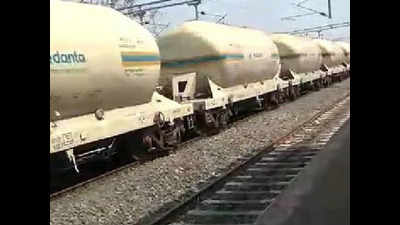- News
- City News
- bhubaneswar News
- Bhubaneswar: ‘Longest’ train of 2 km plies in Odisha
Trending
This story is from February 25, 2019
Bhubaneswar: ‘Longest’ train of 2 km plies in Odisha
The East Coast Railway (ECoR) on Monday ran a 2-km long goods train by amalgamating three freight trains as one unit for the first time in its history. It is called Python Rake due to its long snake size formation while running on the track.

Gupta said they conducted run of this Python Rake on experimental basis.
Key Highlights
- A 2-km long goods train has been run by amalgamating three freight trains as one unit for the first time in its history.
- It is called Python Rake due to its long snake size formation while running on the track.
- 'The length is perhaps a record in the country," Jaideep Gupta, divisional railway manager of Sambalpur division, says.
BHUBANESWAR: The East Coast Railway (ECoR) on Monday ran a 2-km long goods train by amalgamating three freight trains as one unit for the first time in its history. It is called Python Rake due to its long snake size formation while running on the track.
Jaideep Gupta, divisional railway manager of Sambalpur division, said, “The length is perhaps a record in the country though we need to verify past similar experiments in railways history to establish that.”

The train comprised 147 wagons, three brake and guard vans and four engines.The first train or rake of 45 flat wagons was loaded with containers, while the second and third rakes of 51 alumina containers each were empty. These three freight trains were going towards Visakhapatnam Port in Andhra Pradesh.
Gupta said the railway is constructing double line between Khaliapali and Dungripali stations in Sambalpur division. The trains run slowly on a single line and get delayed. “We took a decision to amalgamate three goods trains and cross the railway section to help other stranded trains to pass it. For example, these three trains were taking one hour each to pass the railway section, but now the Python Rake (three trains) took only one hour to pass the area. It saved time and energy and reduced pressure on rail traffic,” he added.
ECoR sources said the zone will carry out these exercises in an organised way soon in different parts of the state and its jurisdiction. “We have seen running of Python Rake with two trains in Agra and other areas of the country. But amalgamation of three rakes and running it in organised way is perhaps the new experiment in the Indian Railways,” said a senior officer of the ECoR.
Jaideep Gupta, divisional railway manager of Sambalpur division, said, “The length is perhaps a record in the country though we need to verify past similar experiments in railways history to establish that.”

The train comprised 147 wagons, three brake and guard vans and four engines.The first train or rake of 45 flat wagons was loaded with containers, while the second and third rakes of 51 alumina containers each were empty. These three freight trains were going towards Visakhapatnam Port in Andhra Pradesh.
Gupta said they conducted run of this Python Rake on experimental basis. “Initially, we had planned to run 101 km from Godbhaga to Balangir station, but we ran 40 km more towards Titilagarh junction inspired by the first 101 km journey. Later, we disconnected a train at Saintala station and the second one at Badmal station,” he added.
Gupta said the railway is constructing double line between Khaliapali and Dungripali stations in Sambalpur division. The trains run slowly on a single line and get delayed. “We took a decision to amalgamate three goods trains and cross the railway section to help other stranded trains to pass it. For example, these three trains were taking one hour each to pass the railway section, but now the Python Rake (three trains) took only one hour to pass the area. It saved time and energy and reduced pressure on rail traffic,” he added.
ECoR sources said the zone will carry out these exercises in an organised way soon in different parts of the state and its jurisdiction. “We have seen running of Python Rake with two trains in Agra and other areas of the country. But amalgamation of three rakes and running it in organised way is perhaps the new experiment in the Indian Railways,” said a senior officer of the ECoR.
End of Article
FOLLOW US ON SOCIAL MEDIA










